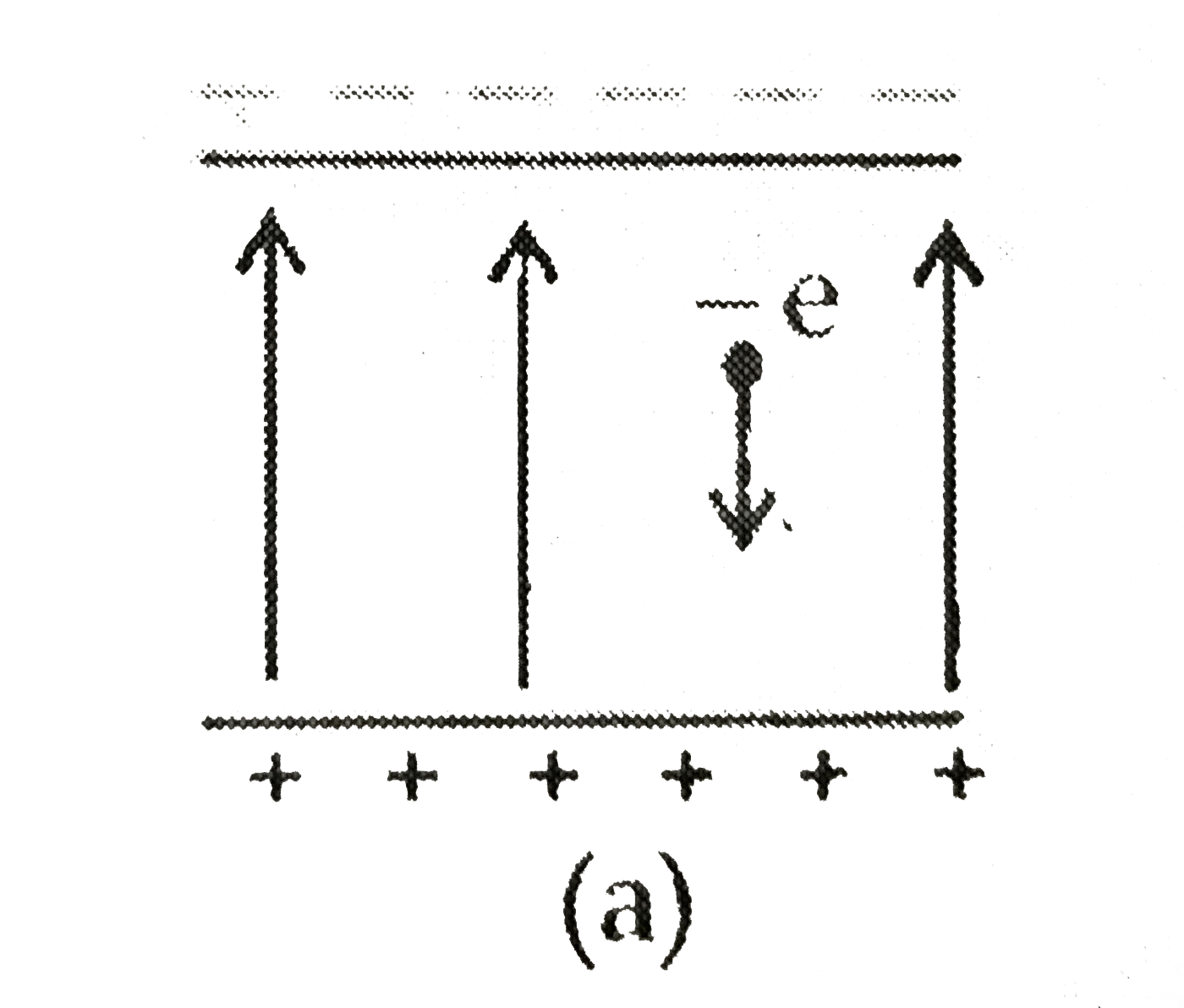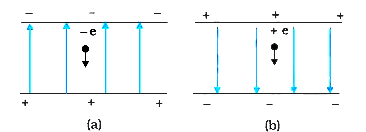An electron falls through a distance of 1.5 cm in a uniform electric field of magnitude 2.0×104NC−1. The direction of the field is reversed keeping its magnitude unchanged and a proton falls through the same distance. Compute the time of fall in each case. Contrast the situation with that of 'free fall under gravity'.
 Solution in Telugu
Solution in Telugu
In Fig. (a) the field is upward, so the negatively charged electron experiences a downward force of magnitude eE where E is the magnitude of the electric field. The acceleration of the electron is ae=eE/me
Where me is the mass of the electron.
Starting from rest, the time required by the electron to fall through a distance h is given by te=√2hae=√2hmeeE
For e=1.6×10−19C,me=9.11×10−31kg.
E=2.0×104NC−1,h=1.5×10−2m.
te=2.9×10−9s
In Fig. the field is downward and the positively charged proton experiences a downward force of magnitude eE. The acceleration of the proton is ap=eE/mp
Where mp is the mass of the proton, mp=1.67×10−27kg. the time of fall for the proton is
tp=√2hap=√2hmpeE=1.3×10−7s
Thus, the heavier particle (proton) takes a greater time to fall through the same distance. This is in basic contrast to the situation of, free fall under gravity' where the time of fall is independent of the mass of the body. Note that in this example we have ignored the acceleration due to gravity in calculating the time of fall. To see if this is justified, let us calculate the acceleration of the proton in the given electric field
ap=eEmp=(1.6×10−19C)×(2.0×104NC−1)1.67×10−27kg
=1.9×1012ms−2
Which is enormous compared to the value of g (9.8ms−2), the acceleration due to gravity. The acceleration of the electron is even greater. Thus, the effect of acceleration due to gravity can be ignored in this exmaple.
Topper's Solved these Questions
- BOOK - VIKRAM PUBLICATION ( ANDHRA PUBLICATION)CHAPTER - ELECTRIC CHARGES AND FIELDSEXERCISE - VERY SHORT ANSWER QUESTIONS13videos
ELECTRIC CHARGES AND FIELDS
- BOOK - VIKRAM PUBLICATION ( ANDHRA PUBLICATION)CHAPTER - ELECTRIC CHARGES AND FIELDSEXERCISE - SHORT ANSWER QUESTIONS6videos
ELECTRIC CHARGES AND FIELDS
- BOOK - VIKRAM PUBLICATION ( ANDHRA PUBLICATION)CHAPTER - DUAL NATURE OF RADIATION AND MATTEREXERCISE - DAM SURE (VSAQ)2videos
DUAL NATURE OF RADIATION AND MATTER
- BOOK - VIKRAM PUBLICATION ( ANDHRA PUBLICATION)CHAPTER - ELECTROMAGNETIC INDUCTION EXERCISE - Additional EXERCISES15videos
ELECTROMAGNETIC INDUCTION
Similar Questions
What is meant by the statement 'charge is quantized' ?
02:23View SolutionState and explain Coulomb's incerse square law in electricity.
03:50View SolutionThe wavelength of electromagnetic radiation is doubled. What will happen to the energy of the photons of the new radiation ?
View SolutionSuppose the loop in Textual Exercise 4 is stationary but the current feeding the electromagnet that produces the magnetic field is gradually reduced so that the field decreases from its initial value of 0.3 T at the rate of 0.02Ts−1 .If the cut is joined and the loop has a resistance of 1.6Ω how much power is dissipated by the loop as heat ? What is the source of this power ?
07:36View SolutionAn electron (mass m_(e ) )falls through a distance d in a uniform electric field of magnitude E. , The direction of the field is reversed keeping its magnitudes unchanged, and a proton(mass m_(p) ) falls through the same distance. If the times taken by the electrons and the protons to fall the distance d is t_("electron") and t_("proton") respectively, then the ratio t_("electron")//t_("proton") .
07:06View SolutionAn electron falls through a small distance in a uniform electric field of magnitude 2×104NC−1. The direction of the field reversed keeping the magnitude unchanged and a proton falls through the same distance. The time of fall will be
11:53View SolutionAn electron falls through a distance of 1.5cm in a uniform electric field of value 2×104N/C, opposite to direction of fall. Compare the time of fall with 'free fall under gravity'.
05:31View SolutionAn electron falls through a distance of 1.5 cm in a uniform electric field of magnitude 2.4xx10^(4) NC^(-1) [Fig.1.12 (a)] . The direction of the field is reversed keeping its magnitude unchagned and a proton falls through the same distance [Fig. 1.12 (b) ]. Complute the time of fall in each case. Contrast the situation (a) with that of free fall under gravity.
03:59View SolutionAn electron falls through a distance of 1.5 cm in a uniform electric field of magnitude 2.0×104N/C(Fig.a)

Calculate the time it takes to fall through this distance starting from rest. If the direction of the field is reversed (fig .b) keeping its magnitude unchanged, calculate the time taken by a proton to fall through this distance starting from rest.
 View Solution
View Solutionएक इलेक्ट्रॉन 2.0×104 न्यूटन/कुलॉम के विद्युत क्षेत्र में 1.5 सेमी गिरता है। क्षेत्र की दिशा बदल दी जाती है। अब एक प्रोटॉन उतनी ही दुरी तक गिरता है । प्रत्येक स्थिति में गिरने का समय ज्ञात कीजिए ।
07:13View Solutionकोई इलेक्ट्रॉन विरामावस्था से किसी एकसमान तथा। ऊपर की ओर ऊध्याधर C विद्युत क्षेत्र E में दी गई दूरी। तक गिरता है। अब विद्युत क्षेत्र का परिमाण अपरिवा रखते हुए इसकी दिशा उत्क्रमित कर दी जाती है। किसी तक प्रोटॉन को विरामावस्था से उतनी ही ऊर्ध्वाधर दरी h तक. इसमें गिरने दिया जाता है। प्रोटॉन के गिरने में लिए गए समय की तुलना में इलेक्ट्रॉन द्वारा गिरने में लिया गया समय है-
05:39View SolutionAn electron falls through distance of 1.5 cm in a uniforth electric field of magnitude 2.0xx 10 ^(4) NC^(-1) The direction of the field is reversed keeping its magnitude unchanged and a proton falls through the same distance compute the time of falls in each case . Contrast the situation with that of 'free fall under gravity'
10:09View SolutionAn electron falls throgh a distance of 1.5 cm in a uniform electric field of magnitude 2.0 xx10^(4) N c^(-1) the direction of the field is reversed keeping its magnitude unchanged and a proton falls through the same distance compute the time of falls in each case contrast the situation with that of free fall under gravity
04:15View SolutionAn electron falls throgh a distance of 1.5 cm in a uniform electric field of magnitude 2.0×104Nc−1 the direction of the field is reversed keeping its magnitude unchanged and a proton falls through the same distance compute the time of falls in each case contrast the situation with that of free fall under gravity
 07:31View Solution
07:31View SolutionAn electron falls through a distance of 1.5 cm in a uniform electric field of magnitude 2.4×104NC−1 [Fig.1.12 (a)]. The direction of the field is reversed keeping its magnitude unchagned and a proton falls through the same distance [Fig. 1.12 (b) ]. Complute the time of fall in each case. Contrast the situation (a) with that of free fall under gravity.
 03:55View Solution
03:55View SolutionAn electron falls through a distance of 1.5cm in a uniform electric field of magnitude 2×104NC−1. The direction of the field is reversed keeping its magnitude unchanged and a proton falls through the same distance. Compute the time of fall in each case.
04:52View Solution

